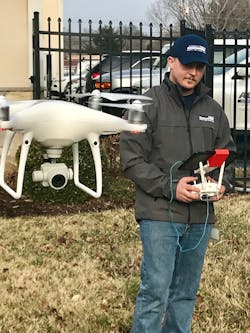Drones: The Next-Generation Installation Tool
The sheer amount of attention that drones are receiving in the security industry has risen significantly in the past few years. From ISC West’s Unmanned Security Expo to even CES, it is difficult to walk the aisles of a show floor without being confronted by the often space-age looking technology.
Most security professionals – whether integrators, end-users or even the vendors themselves – see drones as either a threat or a tool. Those who see them as a threat inevitably gravitate to anti- or counter-drone technologies; and those who see them as a tool are thinking about perimeter security. Today’s aerial-based drones can provide real-time surveillance or gather data using sensors, all valuable information as more end users look to leverage the advantages of this technology.
But there’s another application for drones that integrators in particular may be overlooking. From an integrator perspective, aerial-based drones provide cost- and time-saving benefits that range from eliminating trial and error, to saving on labor costs. Specifically, drone technology has been beneficial in supporting sales, surveying sites and managing customer expectations.
Drones, in fact, can play a key role for integrators in the site survey process. They can cut installation costs and time substantially, making the investment beneficial in the short term and long term.
Surveillance Camera Mapping
An aerial drone can provide real-time views for the placement of surveillance cameras. Rather than using a bucket truck for a full day to survey a customer site – which could cost roughly $1,000 a day – drones can eliminate the need to do so, while simultaneously requiring less human involvement in the process.
Instead of using three people and a truck to survey a customer site, a project that could take up to eight hours to complete, the same thing can be done with a drone and two people in about half the time. Gone are the days of climbing a ladder and installing a camera with an educated guess of the view the camera will capture.
Specifically, when surveying sites, if an end-user has an idea of where to position a camera, the drone can fly up to that location and let the end-user know exactly what image the surveillance camera would capture. This ensures that everything is correct the first time around, and erases the trial and error factor, thus increasing the likelihood that the customer’s expectations will be met. By eliminating the error factor, it costs the integrator less in the long run, and therefore should cost the customer less.
Drones also provide instant gratification – the picture taken by a drone provides an image immediately to a handheld mobile device so that what the customer sees is what the customer will eventually receive.
All of these benefits, in theory, can pay for themselves in one use. An aerial drone that includes all the aforementioned features costs anywhere from $700-$1,000. This could be the cost for an integrator to fix one installation error.
Wireless Site Surveys
Drones can easily assist in wireless site surveys that would normally require the same set of steps as a surveillance camera survey: multiple people, a bucket truck, and a lot of time. Drones enable integrators to provide better accuracy and planning capabilities.
The images captured from an aerial drone can be used to establish a line of sight between wireless radios without the need for a trial and error process. With wireless site surveying, it is important to ensure there are not any obstructions between the radios being used. Drone technology can help ensure that this is the case.
Site Mapping
In some instances, imagery captured by drones can be used to provide high-resolution mapping backgrounds of critical infrastructure. Instead of relying on Google Earth for the latest image, integrators can use a drone to go out and capture their own images in just a few minutes.
This is extremely beneficial, especially in cases where the site is new and not yet on a map. An integrator can then map out potential locations for cameras, then send the drone up to capture real-time footage of what that camera would see.
In this case, drones provide a solution to an issue that, in the past, was technologically unsolvable – and customers are noticing.
Being able to not just tell, but show customers cutting edge technology is a benefit to businesses. In proposal responses, customers are able to see what they are getting as a final product, to an extent, and that is an edge that not all integrators can say they have.
The Next Step
The next step for integrators is to figure out how drone technology can be monetized in a way to either sell to customers or add value for customers who are using it – rather than viewing it as solely a cost-saving measure.
Regardless of the approach, investment in drone technology should be looked at as a money earner, rather than just another purchase. Aerial drones provide an opportunity for security systems integrators to better serve customers, and it is important for integrators to take advantage of cutting-edge technology.
Outside of providing improved and quicker site surveillance and perimeter protection, drone technology can also be used to monitor remote parking lots, protect large infrastructure, such as wind farms, and be used to monitor sports events and concerts.
While it is too early to tell exactly how commonplace drones are going to become – since the laws and regulations surrounding drone technology are still evolving – it is fair to say that drone use is going to continue to grow in the security and surveillance market. Progressive, forward thinking companies who get involved while drones are still in their infancy will be the ones who take advantage of the opportunity.
Dave Sweeney is CEO of Advantech Inc., a Delaware-based security systems integration firm that specializes in custom designed security solutions for the Mid-Atlantic region. Sweeney has 10 years of experience in the security industry and is also a member of Security-Net, a network of independent security systems integrators.



